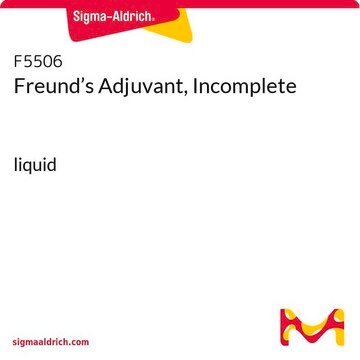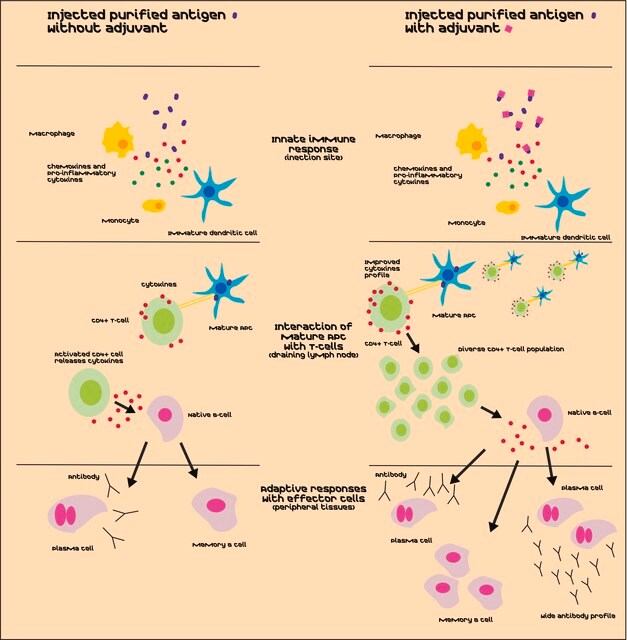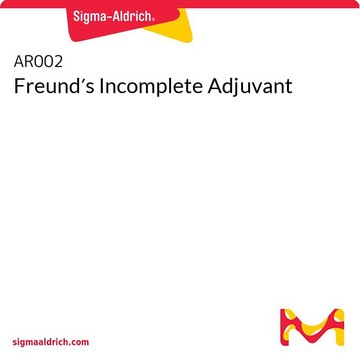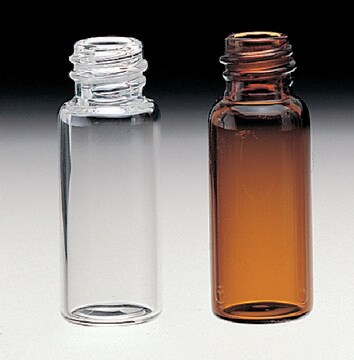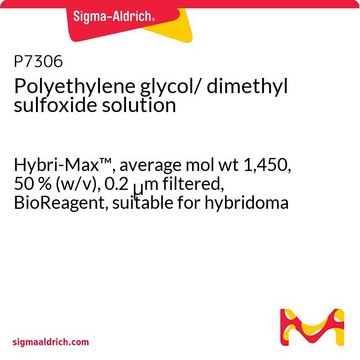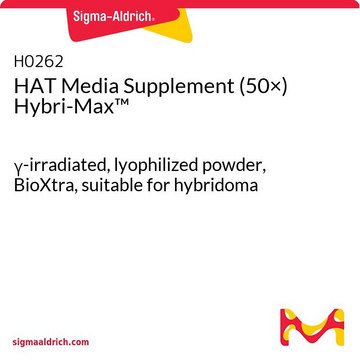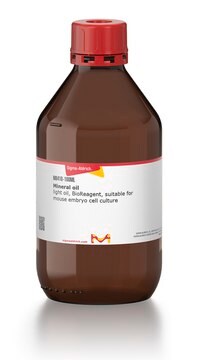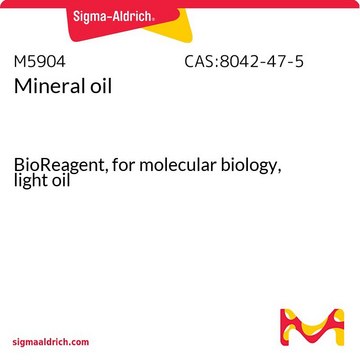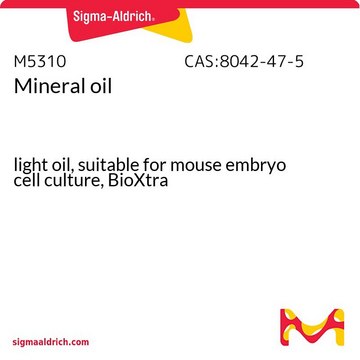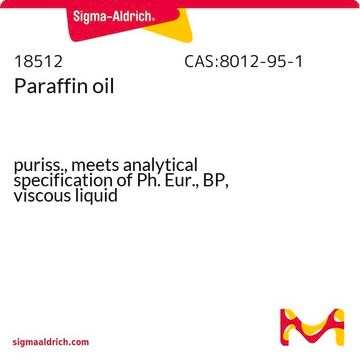344291
Freund′s Incomplete Adjuvant, Modified
Freund’s Incomplete Adjuvant, Modified Contains 85% Drakeol 5NF, 15% Arlacel A. Heat sterilized. Contains zero colony forming units.
Sinónimos:
Incomplete Freund′s Adjuvant
Iniciar sesiónpara Ver la Fijación de precios por contrato y de la organización
About This Item
UNSPSC Code:
41116133
NACRES:
NA.41
Productos recomendados
Quality Level
form
liquid (oily)
manufacturer/tradename
Calbiochem®
storage condition
OK to freeze
color
yellow
shipped in
ambient
storage temp.
10-30°C
General description
Contains 85% Drakeol 5NF, 15% Arlacel A (mannide monooleate emulsifier). Heat sterilized. Contains zero colony forming units/ml.
The word "adjuvant" is derived from the Latin, adjuvare, meaning "to help." During immunization, an adjuvant is generally mixed with the antigen to enhance the rate and amount of antibody formed. The most popular complete adjuvant is that of Freund. It consists of killed and dried microbial cells suspended in an emulsifying oil. Adjuvant without the microbial cells is called "incomplete adjuvant." Complete adjuvant forms a stable water-in-oil emulsion with aqueous solution of antigen. When injected subcutaneously into animals, the emulsified antigen forms a depot from which antigen is delivered slowly and at sustained levels to the animal′s antibody-synthesizing system. The induced antibody response is usually high and sustained. In guinea pigs, an additional benefit from adjuvant is the delayed appearance of hypersensitivity.
Components
10 ml of Freund′s Incomplete Adjuvant homogenized in the following amounts by weight:
85% Drakeol 5 NF (light mineral oil)
15% Arlacel A, mannide monooleate emulsifier
85% Drakeol 5 NF (light mineral oil)
15% Arlacel A, mannide monooleate emulsifier
Warning
Toxicity: Standard Handling (A)
Preparation Note
1. Take the vial of Friend′s Incomplete Adjuvant and fold the aluminum seal back to permit free access to the stopper. Be careful not to break the aluminum ring that holds the stopper in place.
2. Dissolve 50 mg of antigen in 5 ml sterile PBS, pH 7.0-7.3. Maintain or create sterility if at all feasible.
3. Draw the solution into a 10 ml syringe with a 1 inch 21 gauge needle.
4. Insert needle into adjuvant vial and forcibly drive solution into the vial. Withdraw about half the mixture into syringe and force it into the adjuvant vial again.
5. Repeat the mixing procedure in step 4 until a smooth, stable, milky, water-in-oil emulsion forms. Check if the emulsion is complete by expelling a drop from the syringe onto the water surface in a beaker. If the drop remains on the surface and does not disperse when the beaker is agitated slightly, the emulsion is adequate. A properly prepared emulsion is stable for days.
2. Dissolve 50 mg of antigen in 5 ml sterile PBS, pH 7.0-7.3. Maintain or create sterility if at all feasible.
3. Draw the solution into a 10 ml syringe with a 1 inch 21 gauge needle.
4. Insert needle into adjuvant vial and forcibly drive solution into the vial. Withdraw about half the mixture into syringe and force it into the adjuvant vial again.
5. Repeat the mixing procedure in step 4 until a smooth, stable, milky, water-in-oil emulsion forms. Check if the emulsion is complete by expelling a drop from the syringe onto the water surface in a beaker. If the drop remains on the surface and does not disperse when the beaker is agitated slightly, the emulsion is adequate. A properly prepared emulsion is stable for days.
Other Notes
10 ml of Freund′s Incomplete Adjuvant homogenized in the following amounts by weight:
85% Drakeol 5 NF (light mineral oil)
15% Arlacel A, mannide monooleate emulsifier.
1. Take the vial of Friend′s Incomplete Adjuvant and fold the aluminum seal back to permit free access to the stopper. Be careful not to break the aluminum ring that holds the stopper in place.
2. Dissolve 50 mg of antigen in 5.0 ml of sterile PBS, pH 7.0-7.3. Maintain or create sterility if at all feasible.
3. Draw the solution into a 10 ml syringe with a 1 inch 21 gauge needle.
4. Insert needle into adjuvant vial and forcibly drive solution into the vial. Withdraw about half the mixture into syringe and force it into the adjuvant vial again.
5. Repeat the mixing procedure in step 4 until a smooth, stable, milky, water-in-oil emulsion forms. Check if the emulsion is complete by expelling a drop from the syringe onto the water surface in a beaker. If the drop remains on the surface and does not disperse when the beaker is agitated slightly, the emulsion is adequate. A properly prepared emulsion is stable for days.
85% Drakeol 5 NF (light mineral oil)
15% Arlacel A, mannide monooleate emulsifier.
1. Take the vial of Friend′s Incomplete Adjuvant and fold the aluminum seal back to permit free access to the stopper. Be careful not to break the aluminum ring that holds the stopper in place.
2. Dissolve 50 mg of antigen in 5.0 ml of sterile PBS, pH 7.0-7.3. Maintain or create sterility if at all feasible.
3. Draw the solution into a 10 ml syringe with a 1 inch 21 gauge needle.
4. Insert needle into adjuvant vial and forcibly drive solution into the vial. Withdraw about half the mixture into syringe and force it into the adjuvant vial again.
5. Repeat the mixing procedure in step 4 until a smooth, stable, milky, water-in-oil emulsion forms. Check if the emulsion is complete by expelling a drop from the syringe onto the water surface in a beaker. If the drop remains on the surface and does not disperse when the beaker is agitated slightly, the emulsion is adequate. A properly prepared emulsion is stable for days.
Freund, J. 1947. Ann. Rev. Microbiol.1, 291.
Legal Information
CALBIOCHEM is a registered trademark of Merck KGaA, Darmstadt, Germany
Storage Class
10 - Combustible liquids
wgk_germany
WGK 3
Certificados de análisis (COA)
Busque Certificados de análisis (COA) introduciendo el número de lote del producto. Los números de lote se encuentran en la etiqueta del producto después de las palabras «Lot» o «Batch»
¿Ya tiene este producto?
Encuentre la documentación para los productos que ha comprado recientemente en la Biblioteca de documentos.
Los clientes también vieron
Nuestro equipo de científicos tiene experiencia en todas las áreas de investigación: Ciencias de la vida, Ciencia de los materiales, Síntesis química, Cromatografía, Analítica y muchas otras.
Póngase en contacto con el Servicio técnico